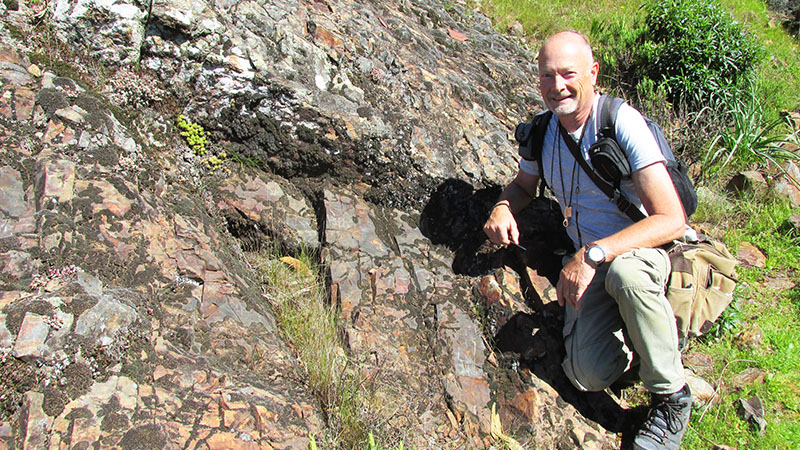A Scientist’s life dedication to Moss
Navigating my way through a green valley that sits just outside of Aljezur, on a road with worse potholes than I ever saw while living in Africa for 18 years, I finally reach my destination: the home of Ron Porley. An acclaimed scientist, more specifically, a Bryologist – someone who specialises in moss. He made the Algarve his home in 2009 after relocating from England.
Ron has written over three books, one of which is part of the highly-regarded Collins New Naturalist series where his contribution is to the 97th book of the natural history archive and is purely dedicated to mosses and liverworts (known as bryophytes) of Britain & Ireland. Worldwide, these are an ancient group of about 24,000 low-growing plants that have no roots or flowers and breed instead by spores.
I quickly became mesmerised by his lifelong dedication to moss and am unsure as to why I haven’t been as fascinated by moss myself – his passion is contagious and evident from the attention to detail he pays to everything he describes to me about his work. Discovering and identifying moss needs patience and dedication, traits that come naturally to Ron.

Malawi (1991)

Uganda (1996)
In the Algarve, Serra de Monchique in particular is Ron’s playground. He explains, “what is interesting about Monchique is the combination of Mediterranean and Atlantic climates, and only certain kinds of mosses grow, for example, on the north-facing slopes of the mountain, whereas others will grow only on south-facing slopes where you get this difference in microclimate.”
He further explains that in the 15th century, when the King came to visit Monchique, he gave away a large part of Foia to the locals, who quickly proceeded to cut down the trees so that their animals could graze. Inevitably, without the native trees and the mosses that grow on them, there was no ‘buffering’ from heavy downpours. Without moss, which releases the rainwater slowly, “the rain washes away the topsoil into rivers and the ocean, and this has happened on Monchique because of the trees being cut down. Today there is so little topsoil left, only nutrient-poor acid ground.”
Nonetheless, moss is resilient and manages to find a niche, be it on rock, the ground or in natural vegetation. Ron has discovered some species on Monchique that are new to science and many kinds that have not been found before by other Bryologists. Because of his specialist knowledge, he was invited to give a talk at the University of Lisbon.
Ron describes his love of mosses as his passport to the world and he travels as much as possible. He explains, “Britain has a tradition of working in Africa discovering mosses. A group of us got together and saw a gap in this knowledge in some parts of Africa.”

Reboulia hemisphaerica Foia NW slope (2021)

Grimmia montana Foia W of summit (2018)


Neodicranella hamulosa Vale das Amoreiras (2021)

By putting a case together for funding, they got support from the UK government to visit Uganda through the Darwin Initiative (a UK government funded program that assists countries with rich biodiversity but poor financial resources). They also visited Malawi, where the team of specialists used their own money with support from the British Bryological Society – founded to study mosses and liverworts. He explains to me the importance of cross-referencing everything that is discovered, an arduous task, as one has to be sure that a plant has not been described before. In the late 19th century, each European country sent their own missionaries and scientists into the colonies with little or no collaboration, and hence the same species may have been collected over and over and given a different name. Today DNA sequencing helps to unravel the confusion, and Ron collaborates with many individuals and institutions to do such specialist work.
The more we speak, it becomes apparent to me how diverse the work of a Bryologist is. Ron explains to me that a team of moss specialists, which included himself, were called in to identify the mosses that were associated with the Ice-man, aka Ötzi, the 5300-year-old mummified body found by hikers in the Italian Alps in 1991. Both Italy and Austria laid claim to him, but when it was discovered that the mosses found both in his satchel and inside his intestines grew only in valleys to the south, it provided evidence that the iceman originated from what we know today as Italy.
Environmentally, moss plays a crucial role, especially in helping to sequester carbon dioxide in large moss-dominated peat bogs that blanket northern landscapes. It is also, as Ron emphasises, “extremely important in the water cycle balance, particularly in tropical rainforests where the moss acts like a sponge. The mosses that are growing on trees form sponge-like cushions, holding onto water and releasing it in a controlled way. If there is no moss on the trees, or even worse still, the trees have been felled, a deluge, thunderstorm or monsoon would just wash off the hillside. This leads to mudslides and other catastrophes that we see played out in the world today because forests are being chopped down and replaced with quick-growing timber, palm oil or land for rearing beef cattle.”

Beate and Ron Porley Ribeira de Torgal (2009)
After speaking with Ron, I am so much more aware of how everything little on this earth works synergistically to ensure that our planet is safe and that the only thing that comes in the way of this is us humans – with our greed and lack of understanding of the balance that nature has created to protect the earth. Luckily there are men like Ron, and women, who work tirelessly and dedicate their lives to ensure that even the things that can seem totally insignificant to us in our daily lives, like moss, are given the recognition that they deserve.
Towards the end of our chat, he emphatically expresses with pure love in his eyes that none of his work on Monchique would have been possible without his wife, Beate, who allows him the freedom to explore and dedicate his time to his work. What is that saying? “Behind every great man is a great woman.”
If you would like to learn more about moss and Ron’s work, the 97th edition of the Natural History Archive is a great place to start.













